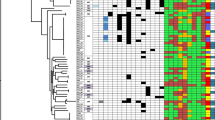Abstract
The susceptibility of 3233 strains of Pseudomonas aeruginosa, isolated primarily in 2001, as agents of infection at 37 medical institutes with various specialties in seven regions of Japan (ranging from Hokkaido to Kyushu/Okinawa), to 18 antipseudomonal agents known to be active against P. aeruginosa was evaluated, in accordance with the National Committee for Clinical Laboratory Standards (NCCLS) guidelines. Of the 18 antipseudomonal agents, including some combinations of β-lactamase inhibitors and antibacterial agents, ciprofloxacin had the lowest minimum inhibitory concentration (MIC)50 (0.25 µg/ml) against P. aeruginosa, followed by meropenem, with an MIC50 of 0.5 µg/ml. The MIC50 of 7 of the examined antibacterial agents (ceftazidime, cefozopran, imipenem, biapenem, gentamicin, tobramycin, and levofloxacin) was between 1 and 2 µg/ml. Among the antipseudomonal agents tested, tobramycin showed the lowest MIC90 (2 µg/ml), which was not significantly different from its MIC50 (1 µg/ml). The MIC90 of the other antibacterial agents examined ranged from 8 to 64 µg/ml and more. The susceptibility of the 3233 strains to the 12 antibacterial agents covered by the NCCLS guidelines was determined according to the standard method of the NCCLS guidelines. The frequency of strains resistant to meropenem, gentamicin, or tobramycin was relatively low (7.5%–8.3%). The frequency of strains showing intermediate to severe resistance to tobramycin was particularly low (8.0%). The frequency of strains resistant to aztreonam, imipenem, or levofloxacin was 16.7%–19.0%, about twice as high as the frequency of strains resistant to tobramycin. The susceptibility pattern of the 3233 strains (isolated from seven regions of Japan) to five antibacterial agents (ceftazidime, piperacillin, imipenem, gentamicin, and ciprofloxacin) was evaluated in relation to the regions from which they were isolated. The MIC50 values of these antibacterial agents did not differ significantly among the regions. However, the MIC90 values of ceftazidime and gentamicin were higher for strains isolated from the Kansai region than for strains isolated from other regions. The MIC90 of ciprofloxacin was higher for strains isolated from the Tohoku, Kansai, and Kyushu/Okinawa regions than for strains isolated from other regions. Of the 3233 strains, 89 were classified as multiple-drug-resistant (imipenem, gentamicin, and ciprofloxacin) strains. Of these 89 strains, 42 were isolated from urine, 17 from sputum or pharyngeal mucus, 13 from pus, 8 from blood, 1 from cerebrospinal fluid, and 8 from other specimens. The frequency of multiple-drug-resistant strains was higher among strains isolated from the Tohoku and Kansai regions than in strains isolated from other regions.
Similar content being viewed by others
Author information
Authors and Affiliations
Corresponding author
About this article
Cite this article
Tsuji, A., Kobayashi, I., Oguri, T. et al. An epidemiological study of the susceptibility and frequency of multiple-drug-resistant strains of Pseudomonas aeruginosa isolated at medical institutes nationwide in Japan. J Infect Chemother 11, 64–70 (2005). https://doi.org/10.1007/s10156-005-0377-z
Received:
Accepted:
Issue Date:
DOI: https://doi.org/10.1007/s10156-005-0377-z




